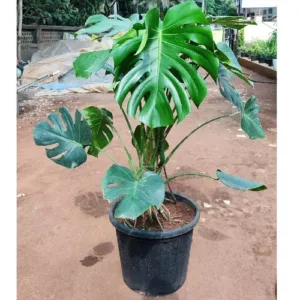No products in the cart.
Shopping cart (0)
Subtotal: ₹0.00
Spend ₹499.00 to get free shipping
Congratulations! You've got free shipping.
Broken Heart Plant
Share:
Please, activate Compare option to use this widget.
₹375.00 Original price was: ₹375.00.₹241.50Current price is: ₹241.50.
🔥 2 items sold in last 3 days
Heart-shaped succulent plants with leaves broken in half, symbolizing heartbreak and making a thoughtful gift.
Estimated delivery:December 9, 2025
Buy more save more!
Buy 3 items and get 5% OFF
on each productBuy from 5 to 4 items and get 10% OFF
on each productBuy 10 items and get 15% OFF
on each productWhy choose kisan nursery & Garden store ?
Recently viewed items:

The Broken Heart Plant is a unique succulent featuring heart-shaped leaves that appear to be broken in half, making it a perfect gift for someone going through heartbreak.
Description: The Broken Heart plant is native to tropical regions of Central and South America. It belongs to the Araceae family and is prized for its heart-shaped, glossy red or pink spathe, which is often mistaken for the flower but is actually a modified leaf. The true flowers are tiny and clustered on a spike called a spadix that emerges from the center of the spathe. The plant’s dark green, glossy leaves add to its ornamental appeal.
What makes it special:
- Heart-Shaped Spathe: The most distinctive feature of the Broken Heart plant is its heart-shaped spathe, which symbolizes love and affection, making it a popular choice for romantic occasions or as a gift for loved ones.
- Long-Lasting Blooms: The flowers of Anthurium plants are long-lasting, often remaining in bloom for several weeks or even months with proper care.
- Air-Purifying Qualities: Like many indoor plants, Broken Heart plants can help improve indoor air quality by filtering out toxins such as formaldehyde, xylene, and ammonia.
- Versatile Decoration: These plants are suitable for indoor cultivation in homes, offices, or public spaces, adding a touch of tropical beauty to any environment.
Planting and Care:
- Light: Place in bright, indirect light. Avoid direct sunlight, as it can scorch the leaves.
- Temperature: Keep in a warm, humid environment with temperatures between 65-80°F (18-27°C). Avoid cold drafts.
- Soil: Plant in a well-draining, porous potting mix rich in organic matter.
- Watering: Keep the soil evenly moist, but not waterlogged. Water when the top inch of soil feels dry, and allow excess water to drain away.
- Humidity: Broken Heart plants thrive in high humidity environments. Mist the leaves regularly or use a humidifier to maintain moisture levels.
- Fertilizing: Feed with a balanced, water-soluble fertilizer diluted to half strength every 4-6 weeks during the growing season (spring and summer).
- Pruning: Remove dead or yellowing leaves and spent flowers to promote new growth and maintain a tidy appearance.
- Repotting: Repot annually or when the plant outgrows its container, using a slightly larger pot with fresh potting mix.
Special Feature: The Broken Heart plant’s heart-shaped spathe makes it a unique and meaningful gift for special occasions such as weddings, anniversaries, or Valentine’s Day, symbolizing love, affection, and devotion.
Uses:
- Indoor Decoration: Broken Heart plants are prized for their ornamental foliage and long-lasting blooms, making them popular choices for indoor decoration in homes, offices, or public spaces.
- Gift Giving: These plants are often given as gifts to express love, appreciation, or sympathy for someone special.
- Event Decor: Broken Heart plants can be used as decorative accents for weddings, parties, or other special events, adding a touch of elegance and romance to floral arrangements or table centerpieces.
Frequently Asked Questions:
- Q: How often should I water my Broken Heart plant?
- A: Water when the top inch of soil feels dry, usually every 1-2 weeks. Adjust watering frequency based on environmental conditions and the plant’s specific needs.
- Q: Why are the leaves of my Broken Heart plant turning yellow?
- A: Yellowing leaves can be caused by overwatering, underwatering, or insufficient light. Check watering practices and lighting conditions to determine the cause and make necessary adjustments.
- Q: Can I grow a Broken Heart plant outdoors?
- A: Broken Heart plants thrive in warm, humid environments and are typically grown indoors in temperate climates. They can be grown outdoors in tropical regions with similar growing conditions.
- Q: How can I encourage my Broken Heart plant to bloom?
- A: Provide adequate light, humidity, and fertilizer during the growing season to encourage blooming. Ensure proper care and environmental conditions to promote healthy growth and flowering.
- Q: Is the Broken Heart plant toxic to pets?
- A: Anthurium plants contain calcium oxalate crystals, which can cause irritation if ingested. Keep out of reach of pets and children, and handle with care.
By following these planting and care instructions and addressing common questions, you can enjoy a healthy and thriving Broken Heart plant in your indoor space, adding beauty and symbolism to your home or office décor.
Be the first to review “Broken Heart Plant” Cancel reply
Related products
Sale
Jade Plant
Rated 5.00 out of 5
Sale
Sale
Sale
Air purifying plant, Indoor plant, PLANT BY LOACATION, PLANTS BY TYPE, SHOW PLANT, TOP PLANTS, PLANTS
Buy English Ivy
Sale
Free Shipping
Home Decoration
Free Shipping apply to all orders over ₹499
Guaranteed Replacments if damaged.
Secure and recyable packaging












Reviews
There are no reviews yet.